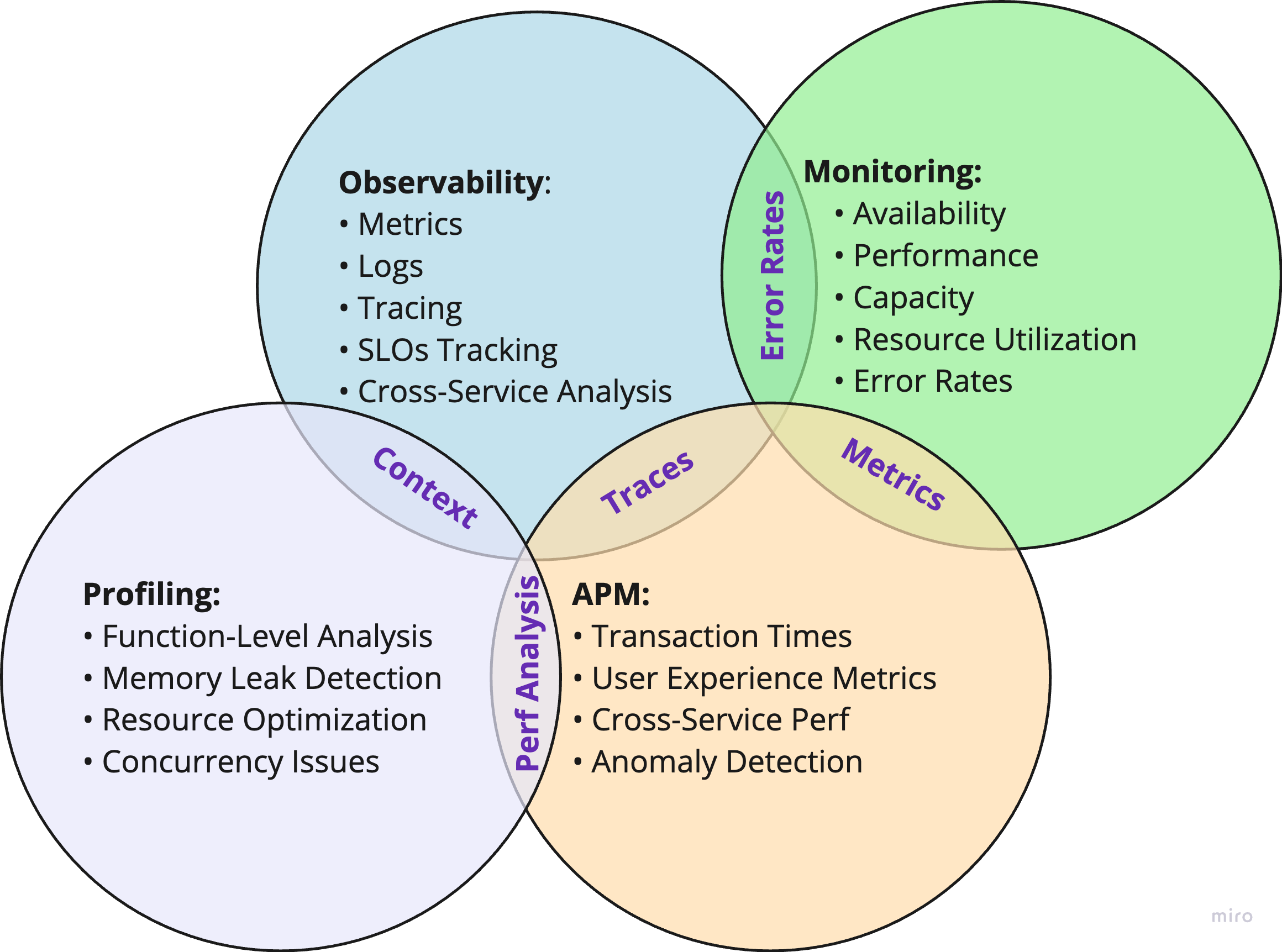Understanding the Differences: Observability vs. Monitoring vs. APM vs. Profiling
In today's cloud-native environments, maintaining optimal application performance requires multiple complementary approaches. While these tools share some features, they serve distinct purposes in modern performance management.

Application Performance Management (APM)
APM's evolution reflects the changing landscape of application architecture. Originally designed for monolithic applications, modern APM tools now handle the complexities of distributed systems and microservices.
Key capabilities include:
- Resource metrics and transaction response times
- User experience metrics and error rates
- Cross-service performance analysis
- Anomaly detection and predictive analytics
Example: An e-commerce platform uses APM to track checkout flow performance, ensuring transaction success rates meet business requirements while monitoring user experience across different regions.
Monitoring
Monitoring provides real-time tracking of system health through predefined metrics, answering "what's happening now?"
Key aspects include:
- System-level metrics and service availability
- Resource utilization and error rates
- Threshold-based alerting
- Basic performance indicators
Example: A cloud-based CRM system uses monitoring to track API endpoint availability and response times, triggering alerts when thresholds are exceeded.
Observability
Observability takes a holistic approach to understanding system behavior in complex distributed environments.
Core elements include:
- Integration of metrics, logs, and traces
- Service Level Objectives (SLOs) tracking
- Cross-service dependency analysis
- Root cause determination
Example: A streaming service uses observability to understand why users in certain regions experience buffering issues by correlating network metrics, CDN performance, and user behavior data.
Profiling
Profiling provides crucial code-level insights for optimization.
Focus areas include:
- Function-level performance analysis
- Memory leak detection
- Resource optimization opportunities
- Concurrency issue identification
Example: A gaming company uses profiling to optimize their matchmaking service, identifying specific functions causing latency spikes during peak hours.
Overlaps and Distinctions
While these tools share capabilities, their focus differs:
- APM and Observability: Both use traces, but observability emphasizes correlation across the entire system.
- Monitoring and APM: Both track metrics, but APM provides deeper application-specific insights.
- Observability and Profiling: Both aid troubleshooting, but at different levels of granularity.
Integration in Practice
Modern organizations typically combine these approaches based on specific needs:
- Monitoring provides immediate health checks
- Observability enables system-wide understanding
- APM ensures optimal user experience
- Profiling drives performance optimization
Example: A financial services app uses monitoring to track system uptime, observability to understand transaction flow issues, APM to monitor user experience, and profiling to optimize trading algorithms.
Conclusion
By integrating these complementary approaches, organizations can build a comprehensive performance management strategy that addresses both high-level system health and granular optimization needs in modern cloud environments. Success lies in understanding each tool's strengths and implementing them in a way that supports overall business objectives while managing integration challenges effectively.
With these tools, you can comprehensively manage application performance and ensure smooth operations.
Learn more about CPU Flamegraphs.
Explore Flamegraph Method Execution.
Measure software performance with key metrics.
Learn more about Application Performance Optimization.
Listen to the Audio Version
If you prefer, you can listen to the automatically generated audio version of this post, which covers key performance management tools like observability, monitoring, APM, and profiling.
